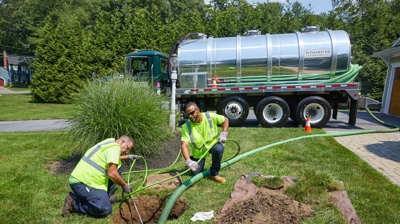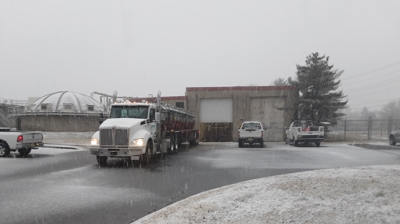Nothing is more critical to your daily operations than sludge hauling. Sludge hauling safeguards your plant or facility’s compliance and operational efficiency.
You can think of it this way. Sludge hauling is to your facility or treatment plant as septic pumping is to your home.
If you are navigating advertised bids, managing an industrial byproduct, or seeking a "no-landfill" solution, this guide is for you. We cover why your sludge needs to be removed, the sludge hauling process, and what to look for in a partner.
Table of Contents
- What Is Sludge and Why Must It Be Removed?
- How Often Does Sludge Need to be Removed?
- How Does Sludge Hauling Work?
- What Are Common Sludge Disposal Methods?
- How Serious is Regulatory Compliance and Reporting?
- What Should I Look for in a Sludge Hauling Company?
- Contact Wind River Environmental
What Is Sludge and Why Must It Be Removed?
Sludge is the semi-solid residue produced during wastewater treatment, containing organic and inorganic materials, pathogens, and trace elements.
Sludge forms during primary and secondary treatment stages when suspended solids settle out of the water. If not removed, sludge reduces treatment efficiency, increases odors, and can lead to system failure or non-compliant discharges.
Regular removal maintains operations at your facility or treatment plant and prevents costly downtime.
How Often Does Sludge Need to be Removed?
Unlike residential septic systems that require pumping every few years, sludge removal is a frequent necessity for municipal and industrial plants and facilities. The exact hauling frequency is highly variable.
Your sludge removal frequency depends on your flow volume and specific internal process:
- Daily Service. In high-volume industrial facilities, such as large food manufacturers, removal is often needed every day, sometimes requiring two or three bulk loads.
- Weekly Service. Other wastewater treatment plants may require scheduled service weekly.
- Trigger-Based Removal. Ultimately, sludge must be removed when it reaches a certain level in your holding tanks. If the process is full and the sludge is not hauled away promptly, the facility cannot continue processing waste.
Dependable, timely sludge removal is critical. Any delay when tanks are full can halt wastewater processing and risk costly, non-compliant discharges.
How Does Sludge Hauling Work?
The sludge hauling process begins with profiling and collecting wastefrom your holding tanks or treatment units. Specialized tractor-trailers transport the sludge to permitted disposal or treatment facilities.
At Wind River Environmental, we take sludge to a centralized facility where advanced systems isolate contaminants and discharge clean, treated water. The process ensures full compliance with environmental regulations and provides a documented chain of custody for our clients’ records.
What Are Common Sludge Disposal Methods?
Sludge disposal is varied and complex, with options ranging from standard land placement to highly sustainable energy conversion.
Sludge can be disposed of through several methods, including:
- Landfilling. Landfilling is used for digested sludge that meets regulatory standards.
- Compositing. Composting mixes sludge with bulking agents to create nutrient-rich fertilizer.
- Beneficial Reuse: Biosolids and Energy. The most sustainable sludge disposal option is beneficial reuse. Sludge is converted into biosolids for agricultural use or processed in anaerobic digesters to produce renewable energy. Class A biosolids can be safely applied to agricultural land, reducing reliance on landfills and supporting sustainability goals.
Choosing the correct disposal pathway is critical. Your sludge hauler will know how to dispose of your sludge safely.
How Serious is Regulatory Compliance and Reporting?
Regulatory compliance and reporting are very serious.
Municipal and industrial facilities must comply with strict environmental regulations for sludge disposal. Your sludge hauler should maintain all necessary permits and provide detailed waste manifests and volume reports.
Proper documentation protects you from liability related to improper disposal. Regulatory record-keeping is a standard part of the service, making your annual reporting much easier.
What Should I Look for in a Sludge Hauling Company?
Choosing the right sludge hauling company is critical to keeping your operations compliant, efficient, and environmentally responsible.
Here are six characteristics you should look for:
#1: Licensing, Insurance, and Compliance
A reputable sludge hauling provider should be fully licensed, insured, and permitted to transport and dispose of sludge under local, state, and federal regulations.
Confirm that the company follows all guidelines in the Clean Water Act and EPA’s Part 503 standards for sewage sludge management. Proper documentation protects your facility from legal risk and ensures regulatory transparency during inspections.
#2: Experience and Technical Expertise
Experience counts. Companies with a strong track record understand the complexities of sludge handling—from pump-out and transport logistics to disposal.
Look for sludge haulers who are familiar with:
- Confined space entry,
- OSHA safety requirements, and
- The specific needs of municipal or industrial treatment systems.
#3: Reliability and Responsiveness
Dependability is essential. Timely removal keeps your treatment plant operating efficiently and prevents costly downtime.
A reliable sludge hauler provides consistent pickup schedules, clear communication, and the ability to respond quickly to emergencies.
A trusted provider offers great customer service and arrives on time. They’ll also know what to do in various scenarios.
#4: Ethical and Environmentally Responsible Disposal
Ethical disposal practices protect both the environment and your reputation.
Ensure that the hauler disposes of sludge only at permitted and certified facilities, never through shortcuts or illegal dumping.
Many responsible companies also offer sustainable options.
#5: Comprehensive Service Capabilities
A well-rounded waste management provider offers more than just hauling.
Look for companies that offer integrated wastewater services such as high-vac cleaning, jetting, pump station maintenance, and emergency bypass pumping.
Put a local “one-stop shop” sludge hauler on speed dial. Doing so will make your life easier and keep your facility or treatment plant up and running.
#6: Pricing and Value
While cost is an essential factor, the cheapest sludge removal company isn’t always your best option.
Instead, focus on the overall value the company provides:
- Experienced staff,
- Safe disposal practices,
- Comprehensive service packages,
- “Johnny on the spot” service, and
- Proven reliability.
All these values often lead to long-term savings and stronger compliance.
In the end, you need a partner who cares about your facility plant just as much as you do.
Need a Sludge Hauling Company? We Can Help.
When compliance, reliability, and sustainability matter, trust Wind River Environmental. With decades of experience and a full-service fleet, we safely and efficiently handle sludge hauling for municipal, industrial, and commercial clients.
Contact us today to schedule service. We’re here to keep your operations clean, compliant, and running smoothly. We proudly serve the Southeast, Mid-South, Mid-Atlantic, and New England.




